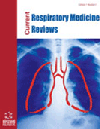-
s Chronic Obstructive Pulmonary Disease and Respiratory Acidosis in the Intensive Care Unit
- Source: Current Respiratory Medicine Reviews, Volume 15, Issue 2, Jun 2019, p. 79 - 89
-
- 01 Jun 2019
Abstract
Chronic obstructive lung disease is a common and preventable disease. One of its pathophysiological consequences is the presence of carbon dioxide retention due to hypoventilation and ventilation/perfusion mismatch, which in consequence will cause a decrease in the acid/base status of the patient. Whenever a patient develops an acute exacerbation, acute respiratory hypercapnic failure will appear and the necessity of a hospital ward is a must. However, current guidelines exist to better identify these patients and make an accurate diagnosis by using clinical skills and laboratory data such as arterial blood gases. Once the patient is identified, rapid treatment will help to diminish the hospital length and the avoidance of intensive care unit. On the other hand, if there is the existence of comorbidities such as cardiac failure, gastroesophageal reflux disease, pulmonary embolism or depression, it is likely that the patient will be admitted to the intensive care unit with the requirement of intubation and mechanical ventilation.


